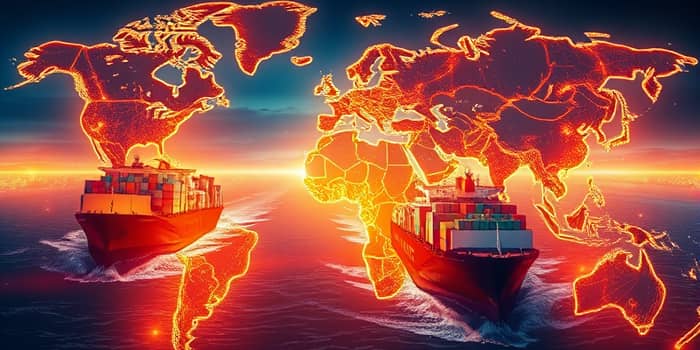
The acceleration of trade conflicts among major economic powers has ushered in an era defined by unpredictability and tension. Nations deploy punitive measures to safeguard domestic interests, and the escalating reprisals reverberate across continents. In this comprehensive analysis, we dissect the forces driving trade wars, quantify their economic toll, and explore strategies that companies and policymakers employ to navigate this complex terrain.
A trade war occurs when countries impose restrictions—such as tariffs, quotas, or subsidies—against each other to protect domestic industries or retaliate against unfair practices. Policy makers often cite perceived unfair trade practices as justification, but the outcomes can rapidly spiral into broader economic strife. Common triggers include currency manipulation accusations and national security concerns.
Governments typically wield an array of instruments to influence cross-border commerce:
In 2025, the United States unveiled the so-called “Liberation Day” tariffs, initially imposing rates as high as 145% on certain Chinese imports before scaling them back to 30%. The measures targeted sectors ranging from electronics and minerals to pharmaceuticals, though some essential medical supplies were granted temporary exemptions. In response, China, Canada, Mexico, and other US partners levied their own barriers, fueling concerns that the world is witnessing the largest trade war in history in both scope and potential fallout.
This tit-for-tat escalation has had immediate ripple effects on global supply chains, with manufacturers scrambling to reroute shipments and adjust production schedules. The specter of further retaliation has rendered negotiations more arduous, even as stakeholders explore fresh diplomatic channels and interim agreements to stem the tide of restrictive measures.
International bodies now estimate that global merchandise trade will decline by 0.2% in 2025, a downturn that could deepen to 1.5% if hostilities intensify. In North America, exports are forecast to plummet by a staggering 12.6%, exacerbating regional economic slowdowns. Service sector trade is not immune, with projected growth sliding to 4%, down from earlier optimism.
The most severe impacts are felt by less-developed, export-dependent economies, which lack the fiscal buffers to absorb sudden shocks. Analysts warn that the cumulative effect of tariffs and uncertainty will act as a brake on global GDP growth, threatening gains achieved in previous decades of liberalization.
At the firm level, 42% of exporters across the United States, China, the EU, and key Asian markets anticipate turnover declines of 2-10% in the year following the 2025 tariff hikes. Less than half of surveyed companies now expect export growth—a stark drop from the 80% who were optimistic before the escalation.
Rising input costs and currency volatility have prompted 27% of firms to consider temporary production halts. To mitigate risks, many businesses are seeking to accelerate efforts to diversify supply chains and explore new markets. Notably, 77% of Chinese companies are boosting capital expenditures in strategic regions, while 45% of German firms focus on operational efficiency and cost reduction.
Financial markets responded swiftly to tariff announcements. US stock indices tumbled, and the dollar’s value weakened against major currencies. Investors grew increasingly wary of lingering inflationary pressures induced by higher import costs, and recession risk forecasts for 2025-2026 climbed from 20% to 33%. Yet, most macroeconomists refrain from declaring a recession as the base case, citing strong employment data and consumer spending resilience.
Historical studies, including assessments of the 2018-2019 US-China tariff saga, reveal that bearing most of the burden often falls to domestic consumers and importers. Higher duties trickle down to end users via elevated prices, eroding purchasing power and dampening demand.
Highlighted below is a concise table summarizing the latest estimates and survey findings related to the current trade war landscape.
The 2018-2019 trade confrontation between Washington and Beijing offers a sobering lesson in how swiftly protectionist measures can upend global value chains. Direct US-China trade collapsed under punitive tariffs, while indirect flows through intermediary countries provided only partial relief. As a result, companies experienced severe logistical bottlenecks and sharply elevated costs.
Looking ahead, even temporary bilateral agreements are unlikely to restore the pre-conflict equilibrium. Economists caution that persistent policy volatility will compel every open economy to adapt or risk marginalization. Countries with limited diversification and weak fiscal support will be especially vulnerable to oscillating trade norms and sudden shifts in market access.
Global trade wars have evolved from sporadic skirmishes into sustained battles that reshape economic geography. The combination of high tariffs, rapid escalation, and mounting uncertainty underscores the importance of agility for businesses and strategic foresight for policymakers. By embracing robust risk management, diversify supply chains rapidly, and pursuing meaningful diplomatic engagement, stakeholders can mitigate damage and chart a course toward renewed stability and growth.
Ultimately, navigating the current landscape demands a balanced approach—one that acknowledges the protective instincts driving tariffs while leveraging cooperation and innovation to preserve the dividends of an interconnected global economy.
As trade policies continue to evolve, continuous monitoring and flexible strategies will be essential. Businesses that invest in digital technologies and sustainable practices may gain competitive advantages, turning challenges into opportunities. Ultimately, the future of international trade hinges on collaboration and informed decision-making.
References













